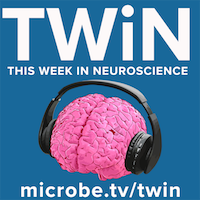TWiN explains the observation that in mice, the HIV-1 co-receptor CCR5 closes the temporal window for linking different memories.
TWiN describes experiments demonstrating that gut injection of alpha-synuclein fibrils in mice converts endogenous alpha-synuclein to a pathologic form that spreads to the brain and leads to features of Parkinson’s disease.
TWiN answers listener questions on sex in neuroscience studies, rotating memories in the brain, odorant receptors in the brain, and neutrophils that promote neuron survival.
Stefano joins TWiN to discuss his work on understanding genomic decoding of neuronal depolarization by stimulus-specific transcriptional regulators.
Ori, Jason, and Vincent discuss the use of antibodies to neutralize amyloid-β seeds before their deposition becomes detectable in transgenic mice, and the finding that the preclinical phase of Alzheimer‘s disease may be a late manifestation of earlier pathogenic seed formation.
Ori, Jason, Erin, and Vincent dissect a study that utilizes single-cell RNA sequencing to reveal the genes that underlie remote memory storage in the medial prefrontal cortex of the mouse.
Maria joins TWiN to explain how single-cell transcriptomics is being used to reveal the evolution of the brain, at a cost of about $1 per neuron.
TWiN explains how a cytokine produced by neurons activates microglia which modify the extracellular matrix and remodel synapses, leading to memory consolidation.
Erin and the TWiN team explain how dopamine neurons encode reward probability and uncertainty, and their roles in attention-based learning and risk-taking such as gambling and addiction.
The synaptics launch the first episode of TWiN by revealing their training, research interests, and goals for the podcast.





